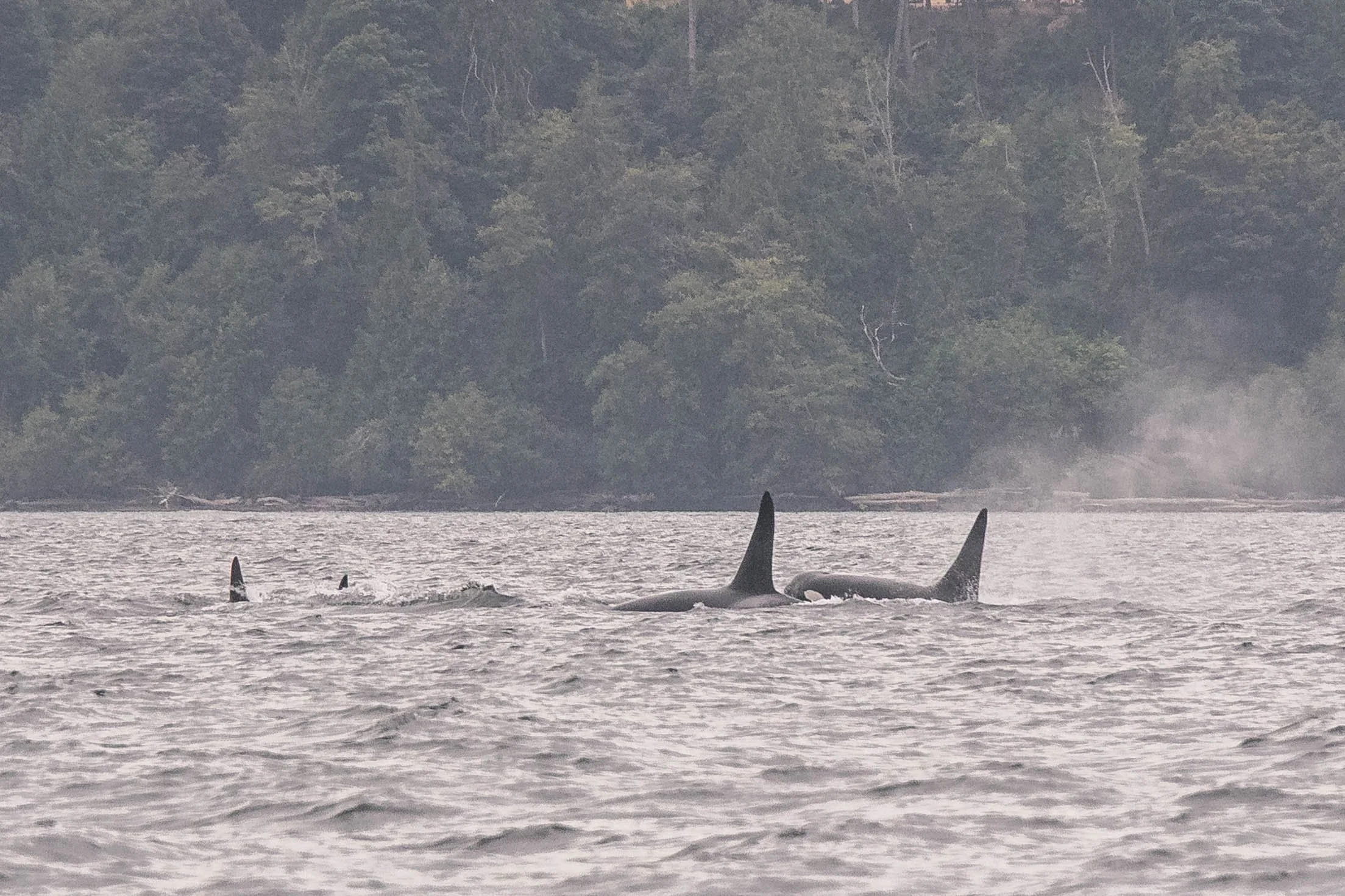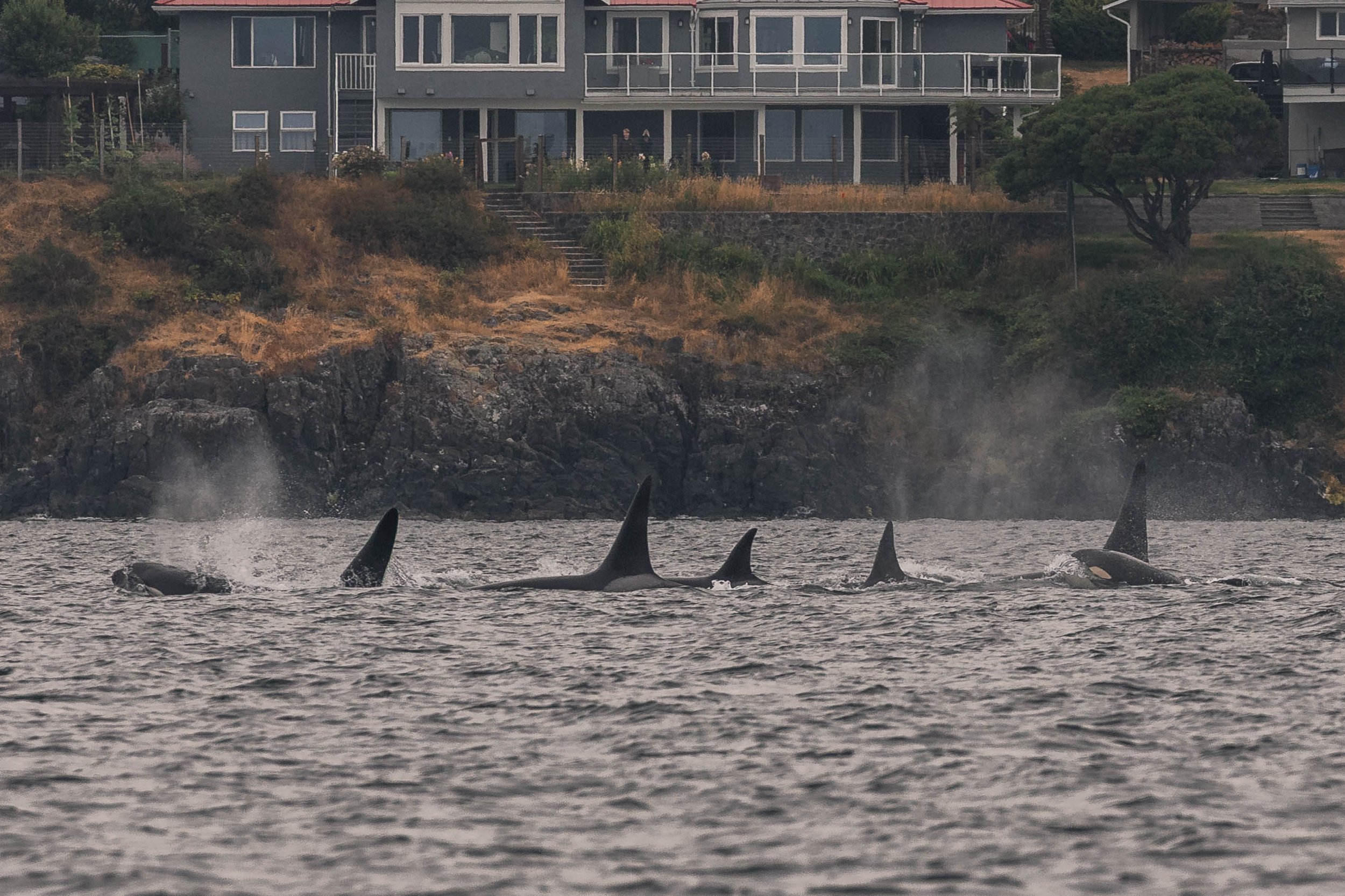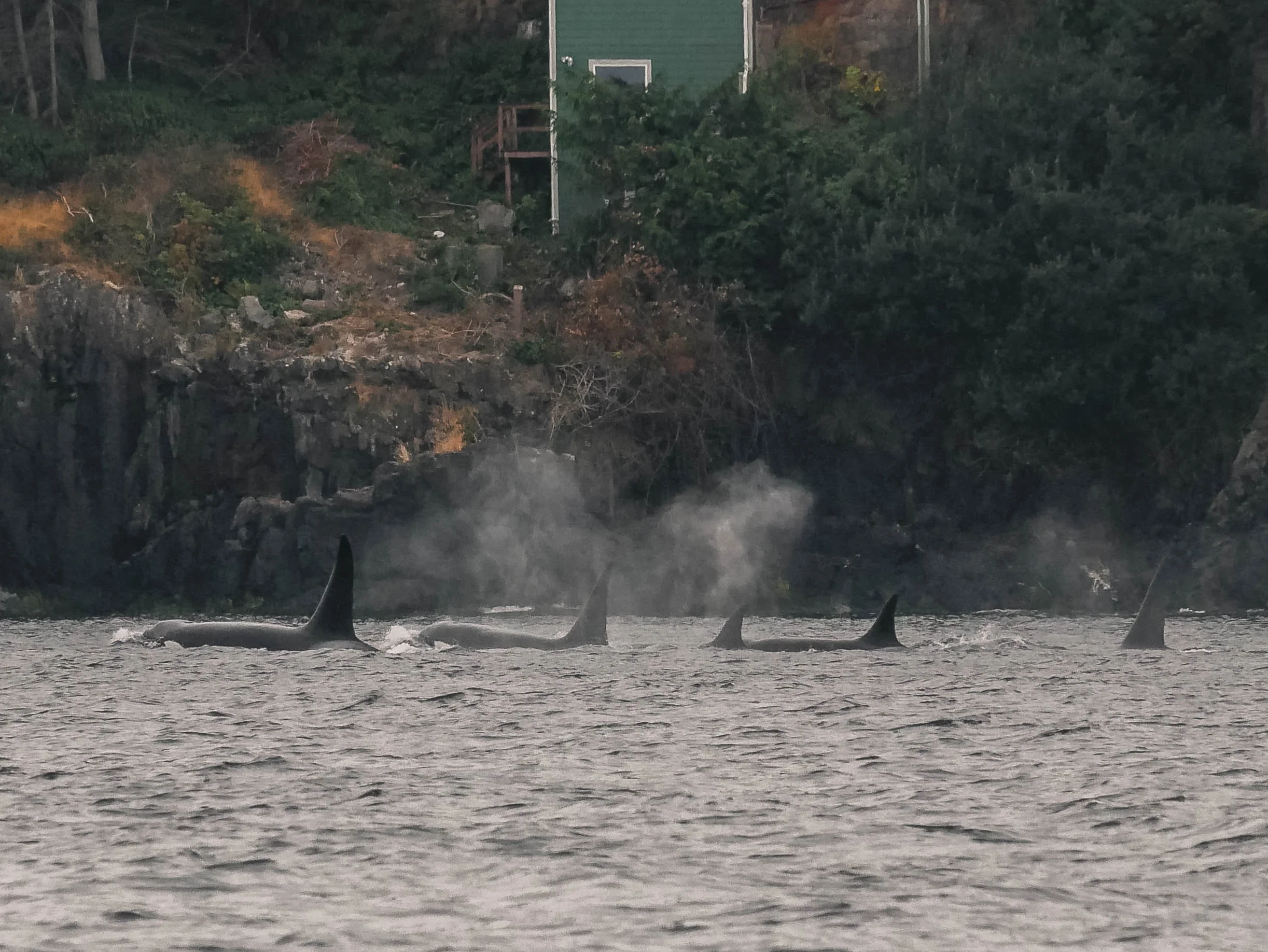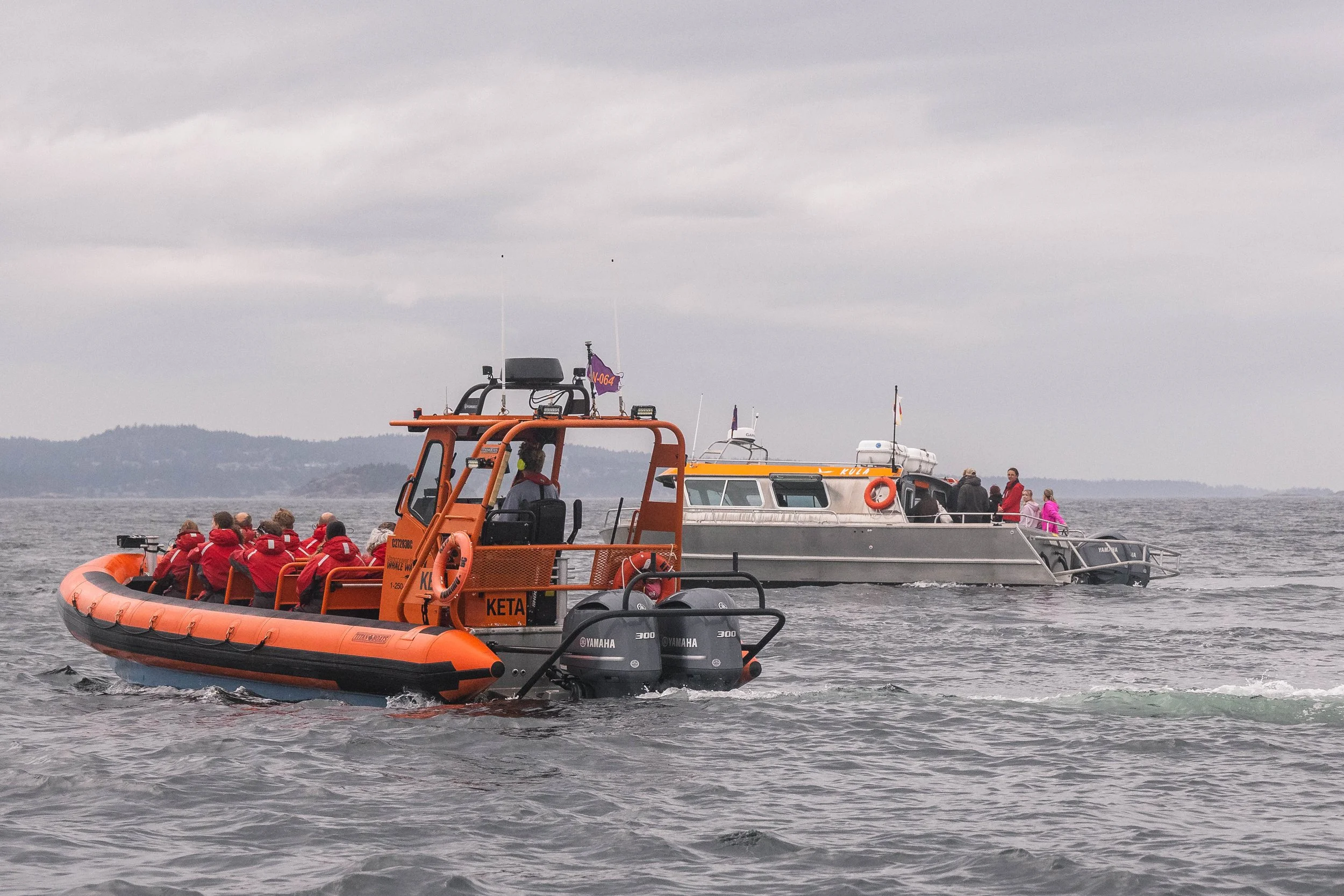August 5, 2025, 3:30 PM - Orca and humpbacks in the Strait.
This afternoon the whole fleet was off the dock once again, eager to see what the Strait of Georgia had in store. With calmer winds than the morning, we set our sights north, knowing that conditions would give us a wider search range. The Strait was lively with waves, and while it took us some time to spot activity, patience paid off in the best way imaginable: the tall black fins of orca breaking the surface.
We had found not just one, but two family groups of transient, the T065Bs and the T101s, consisting of:
T065B Chunk ♀ (1993)
T065B1 Birdsall ♂ (2011)
T065B2 Nettle ♂ (2019)
T065B3 Rook ♂ (2023)
T101 Reef ♀ (≤1969)
T101A Rush ♂ (1993)
T101B Lagoon ♂ (1997)
Orcas are one of the most studied marine mammals in the Salish Sea, and researchers identify them individually by carefully noting the shape and size of their dorsal fins, as well as the unique saddle patches and eye patches. Each whale’s markings are slightly different, sometimes as subtle as the shape of a notch or the shading of a patch. Out on the water, we take photographs of these features and compare them to identification catalogues, which allow us to put names and histories to the whales we encounter.
As we paralleled them, these apex predators showed us just how far-ranging they are. Transient orca are known to cover over 100 kilometres in a single day, patrolling their territories in search of prey like harbour seals, sea lions, and porpoises. Every surface felt like a window into their constant, purposeful movement, a reminder of the stamina and strategy required to survive in the Salish Sea. Eventually, the orca steered us back southward, and as though the ocean had more to offer, another surprise awaited us.
On the horizon, we suddenly saw the unmistakable bushy blows of humpback whales. Switching gears from tall fins to massive tails, we carefully approached and discovered we were in the company of Kappa (BCX0158), Kappiroto (BCX0158 calf of 2025), and Smoke (BCX2183). Unlike orca, humpbacks are identified primarily by the unique black-and-white patterns on the underside of their tail flukes. Their dorsal fins also offer distinguishing shapes, but it’s the tails that act like a fingerprint; no two are alike. As with orca, we use photos and compare them against catalogues to determine exactly which individuals we are seeing.
Humpbacks, unlike orcas, are not permanent residents of the Salish Sea. These giants make an extraordinary journey, travelling thousands of kilometres from their tropical breeding grounds in Hawaii to the nutrient-rich waters of British Columbia and Alaska to feed. Along the way, they burn massive energy reserves, and it is estimated that by the time they arrive in the North Pacific, they may have lost up to 30% of their body weight. Here, in these productive summer waters, they must consume several thousand kilograms of fish and krill before turning south once again. Watching Kappa, the young calf, alongside its mother and the ever-reliable Smoke, was a moving reminder of how much endurance and resilience are woven into humpback life history. After giving them plenty of space to continue feeding, we made our way onward.
Before long, another species appeared along the rocky shoreline, Harbour Seals hauled out, basking in the late-day light. While we don’t identify seals as individuals on our tours, scientists who study them can. Much like whales, seals bear unique markings and scars that can be used to recognize one animal from another, providing valuable information about their lifespans, habits, and population health.
With the sun dipping lower, our bows turned back toward Nanaimo. From orca on patrol to humpbacks replenishing after migration, to the quieter moments with the Harbour Seals, it was the kind of day that showcased not just the diversity of life in the Strait of Georgia, but the interconnectedness of it all. Every fin, every tail, and even every whiskered face has a story, and we were fortunate enough to share a few of them today.
Photos taken by Desarae Poier, Hayleigh Hilbert and Jordan Robinson.
T101A Rush with T101B Lagoon following. Photo by Desarae Poier.
T101A Rush. Photo by Hayleigh Hilbert.
T101A Rush and T101B Lagoon following the others. Photo by Jordan Robinson.
T101A Rush with T101B Lagoon behind him. Photo by Desarae Poier.
T101A Rush. Photo by Desarae Poier.
A good look at T101A Rush’s eye patch. Photo by Desarae Poier.
T065B1 Birdsall followed by T101 Reef. Photo by Desarae Poier.
Right to left: T065B1 Birdsall, T101A Rush, T065B Chunk, T101 Reef and T101B Lagoon. Photo by Desarae Poier.
Charging ahead! Photo by Desarae Poier.
T101A Rush followed by T065B1 Birdsall, T065B Chunk, T101 Reef, T101B Lagoon and T065B3 Rook surfacing beside. Photo by Desarae Poier.
How many orca can you spot in this photo? Photo by Hayleigh Hilbert.
T065B Chunk. Photo by Desarae Poier.
Surfacing together. Photo by Desarae Poier.
T101A Rush with a spy hop. Photo by Desarae Poier.
Kappa fluking with the B.C. Ferry on the horizon. Photo by Jordan Robinson.
Kappa fluking. Photo by Desarae Poier.
The front side of Kappa’s tail. Photo by Desarae Poier.
Breaching for the sky! Photo by Desarae Poier.
Coming in for a landing. Photo by Desarae Poier.
A round calf! Photo by Desarae Poier.
A big splash! Photo by Desarae Poier.
A chin slap coming your way. Photo by Desarae Poier.
Another breach! Photo by Desarae Poier.
Kappa diving with Kappiroto following. Photo by Desarae Poier.
Cormorants on the rocks. Photo by Desarae Poier.
Some very round seals. Photo by Desarae Poier.
Harbour Seals lounging. Photo by Desarae Poier.
Keta and Kula watching whales. Photo by Jordan Robinson.
Keta and Cascadia watching the whales. Photo by Desarae Poier.





























